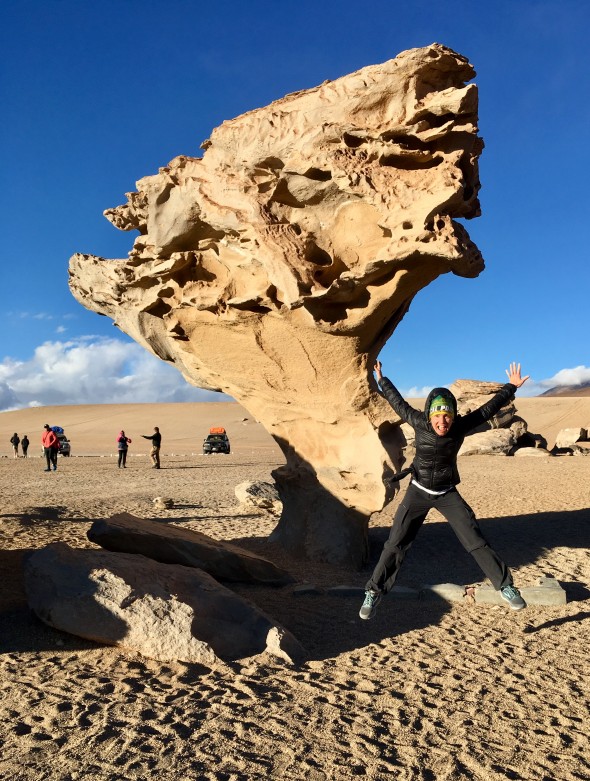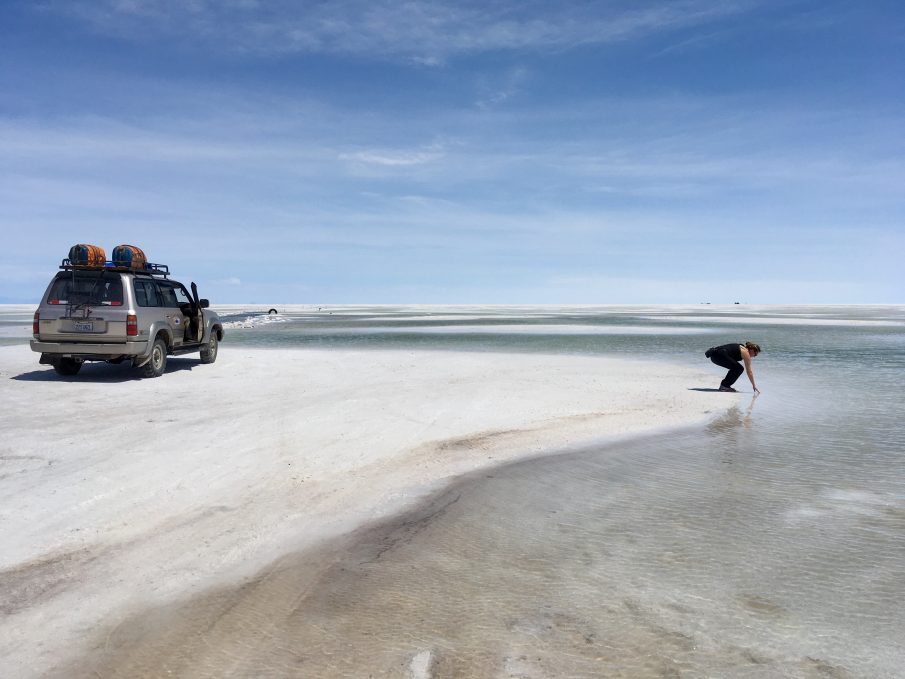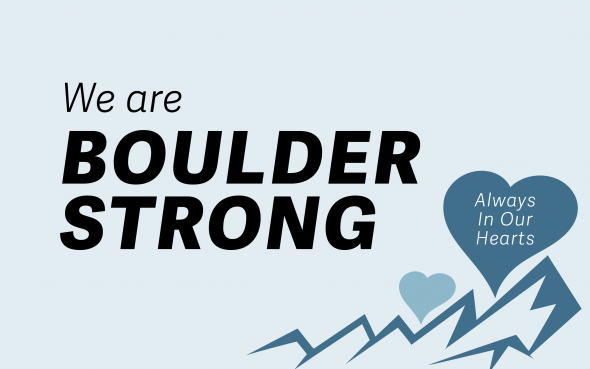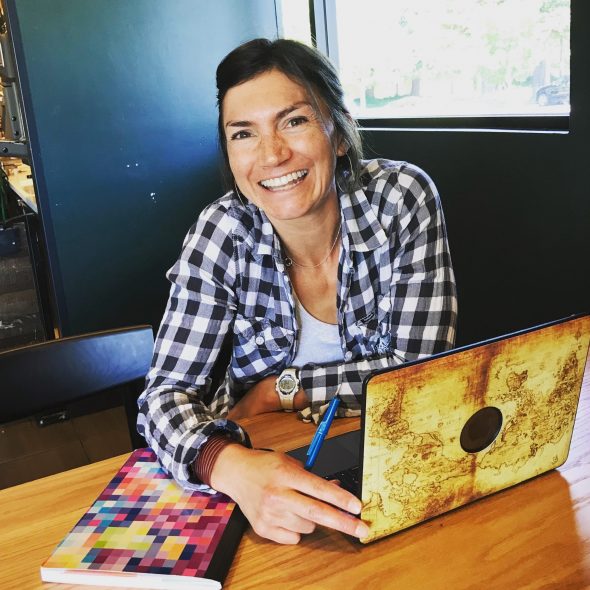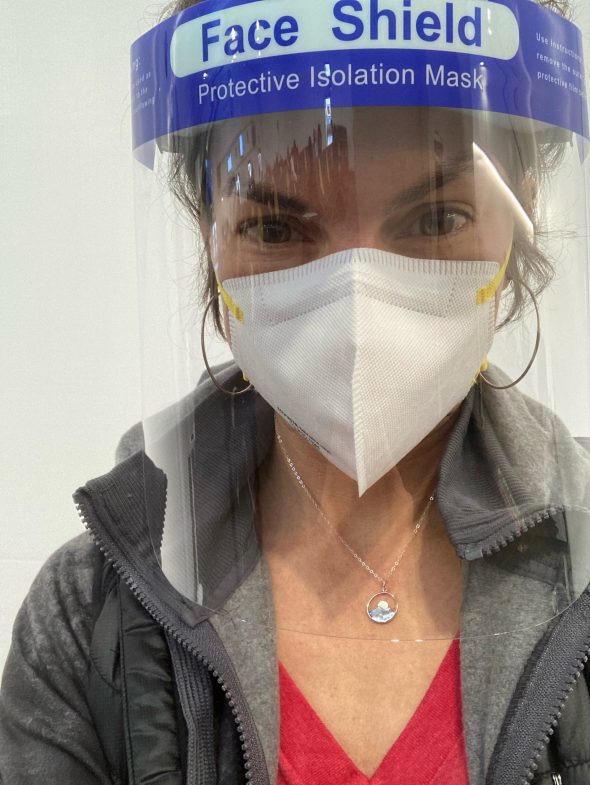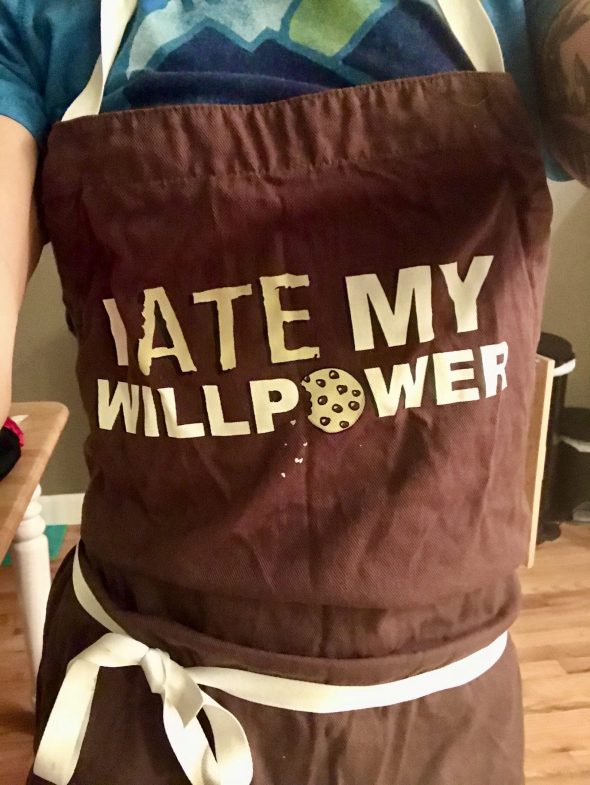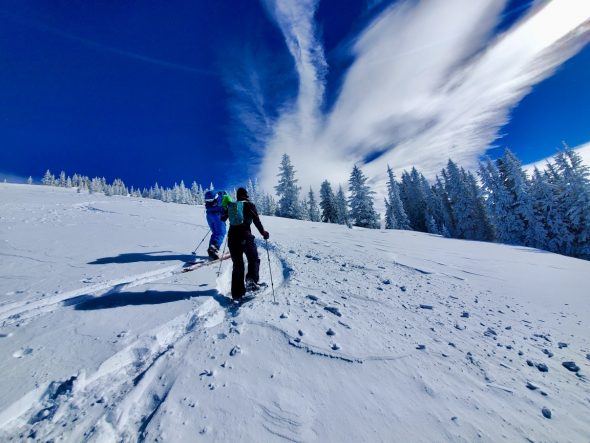Querida Carrie- she is a dear friend who loves and has grown from her own travel experiences, and whose opinions I value. One factor in me moving to Colombia was her and her husband’s joint suggestion about it as a possibility for me to live and work.
We decided on Bolivia because she hadn’t visited it during other SA travels with her husband Trent a couple years ago. Both of us busy leading up to the trip, we outlined a general itinerary with priorities for visiting but didn’t make any reservations except for the very first hotel. I got a lot of recommendations and advice from my well-traveled German Spanish-speaking housemate, Stephanie, who had visited Bolivia a couple years ago. She told me it’d be better to arrive and get our bearings in this huge, unique, and somewhat impoverished country instead of following our American tendencies to make a bunch of plans ahead of time.
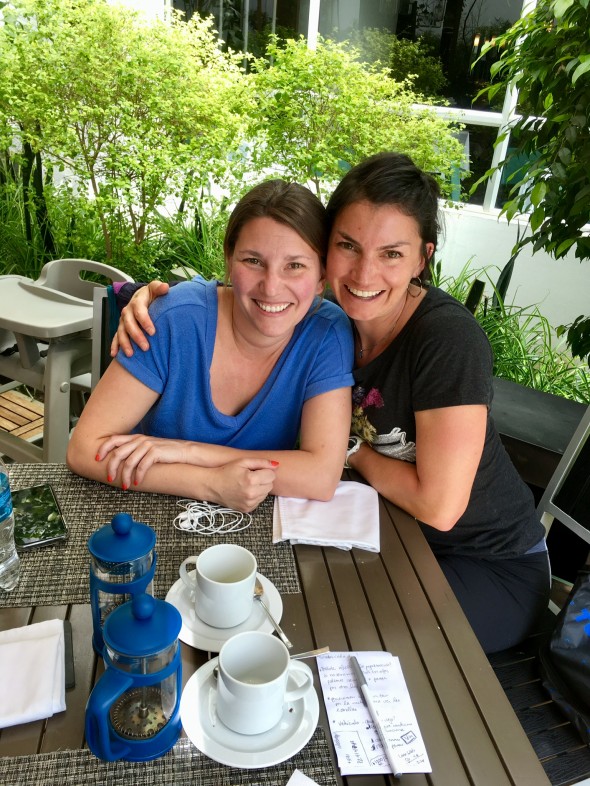
As United States citizens, we learned we had to apply for a a Bolivian visa. Carrie had to mail in her passport and get it taken care of before the trip. I prepared all my documents and made a trip to the Bolivian Embassy in Bogotá, but upon arriving and speaking with the consul I learned that because I’d be coming from Colombia, I would just need to pay for my visa & present my documents at the airport in La Paz. But I second-guessed the Bolivian representative and politely asked her to write down her contact information, as if I would actually give her a call from the La Paz airport if the Immigration officials turned me down to enter the country. Ha!
Well, it all went really smoothly with my departure from Bogotá and entry to Bolivia. I waited a couple blurry-eyed hours in the airport for Carrie’s plane to land around 3:30am local time. Even though sleep-deprived, we shrieked with joy at seeing each other after over a year and now being really excited to explore some new lands together.
I’ve never tried to check into a hotel at 4am, and though the front desk staff of the big establishment were very accommodating (later even waiving the early check-in fee), we had to wait until 7am. For the first 30 minutes we were happy to sit on the lobby couches and continue with our catching-up, but then we both began to fade. We ended up snoozing and were gently woken by one of the staff who likely wanted to keep the tourist riff-raff off the lobby furniture. So to our benefit were let into our comfy room about 45 minutes early.
We got a good 3 hour nap and lunch at the hotel restaurant then went out to ride the Cable Car having heard it’s a great and cheap way to get an overview of this mountainous city. The windings and steep grades of the streets are pretty amazing. The only buses we saw were very small, more like big vans, and it appeared to me the best way to get around was walk or take the cable cars.
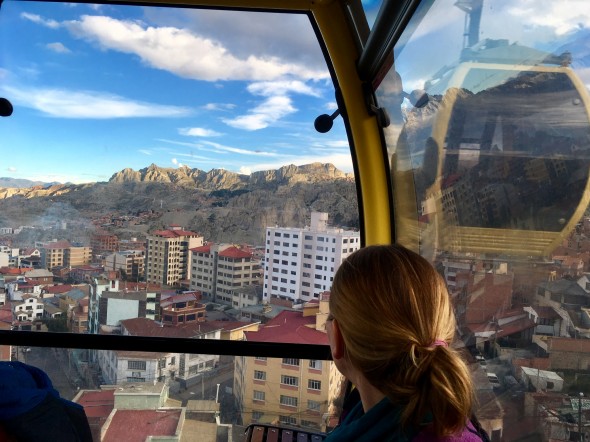
What caught my attention the most was the attire of many of the native women. Very short in stature, they wear many layers of colorful skirts (literally it could be up to 20 layers) which makes them look extremely round. Many wear a hat that I would consider more of a man’s style in the US, kind of a rounded-top top hat. I learned that the roots of the many layered skirts is traditional garb for dances that accentuate the hips, and also that practically-speaking the layers are for warmth in this high-altitude chilly climate. (La Paz is home to the highest-altitude airport in the world at almost 12,000 feet). I still have to figure out the story of the top hats.
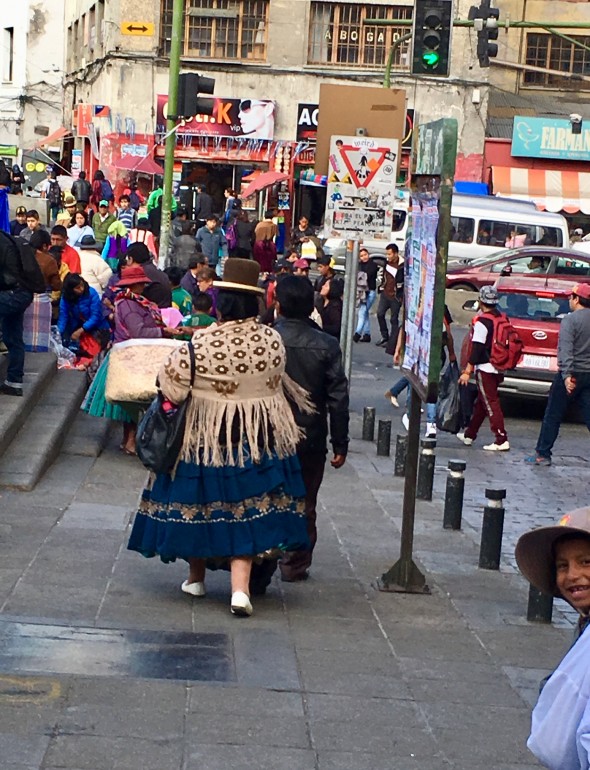
We made a plan for our next few days after speaking with a couple locals and doing an internet search with reviews on a few tour operators who take tourists into the extensive salt desert and surrounding amazing landscapes. We chose one and then had to decide on how to get to the launch point for the tour: the mining town of Uyuni. It would be a 9-12 hour bus ride or a 45 minute flight. It seemed obvious from a time & comfort standpoint but the cost difference was huge. This is often the case and one must weigh the realistic factors and the timeframe for travel. I’ve never traveled overnight on a bus in Latin America so I was a little more open to the option, but Carrie has, twice, and said it was a horribly uncomfortable experience both times (mostly because of complete lack of sleep). So we booked our flights.
We arose at 6am the next day to catch a taxi to the airport. The flight was short and smooth and we arrived in Uyuni where the owner of our tour was waiting for us with a sign so we could easily find him (in the crowd of 6 people).
That evening we’d take a trip into the salt flats to see the sunset and stars. We exclaimed with delight as we entered the Salar – its a landscape as I’ve never seen before. While the sun is shining, its impossible to look around without sunglasses because the white while salt floor is so brilliant. April is just between the end of the rainy season and the beginning of the dry season, so we still encountered water. Actually this was great because it creates a beautiful mirror to reflect the bluest sky I’ve ever seen as well as heaping clouds and surrounding mountains.
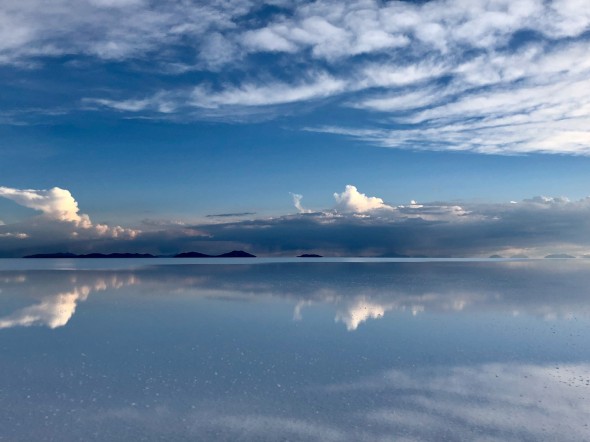
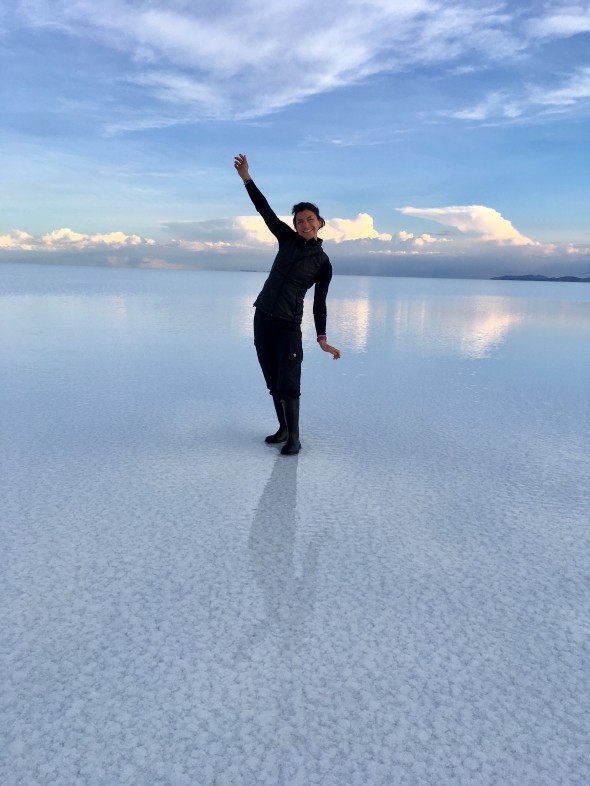
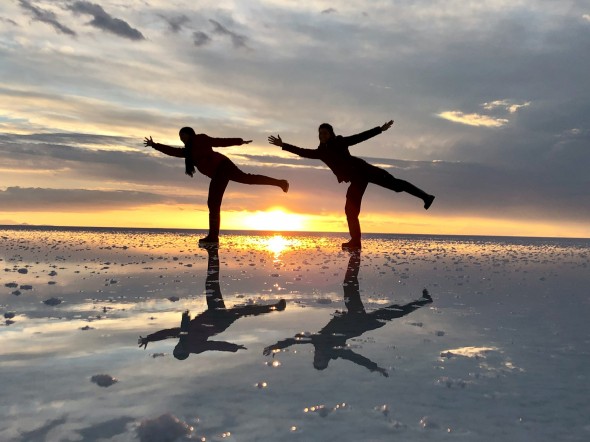
We took many pictures, our guide Blas told us some info about the land and geography, and then he proceeded to set up one of the most fun photo sessions….the extreme flatness of the land and the white-white backdrop creates the ability to play with the fore-and-background perspectives, making photography “special effects” really easy. Carrie and I laughed til our abs hurt as Blas directed like a pro and managed our iPhones like they were his own. I loved that the pictures were taken on our own phones and it didn’t have to be an add-on for us to purchase the photos afterwards.
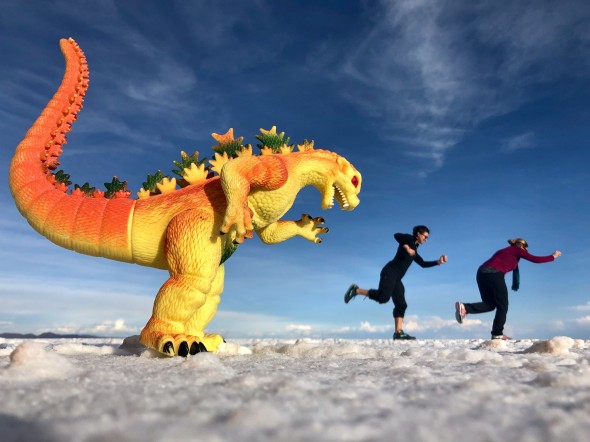
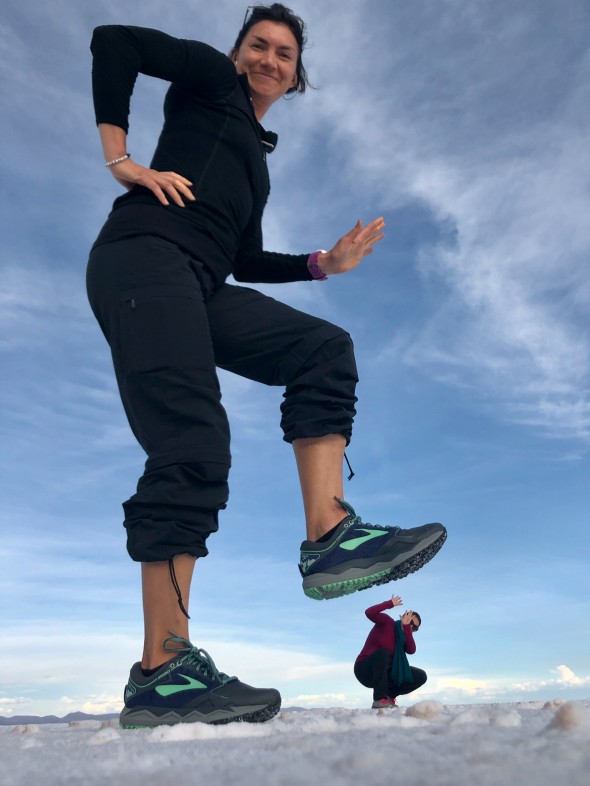
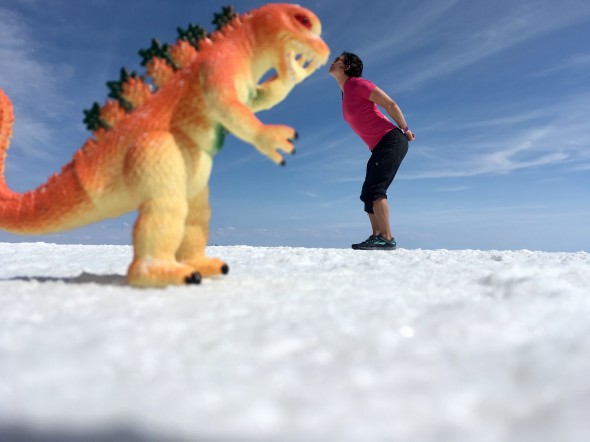
We had brought wine and snacks, Blas provided us with boots and set up a table where we spent close to 2 hours sipping, chatting, and enjoying the horizon eating up the sun as it fell…in truly one of the most amazing settings I’ve experienced. It was partly cloudy so we didn’t see a full sky of stars but to my delight the 360 degrees of mountains around us harbored darkening clouds with lightning flashing – plenty far not to be a threat but instead a splendid show.
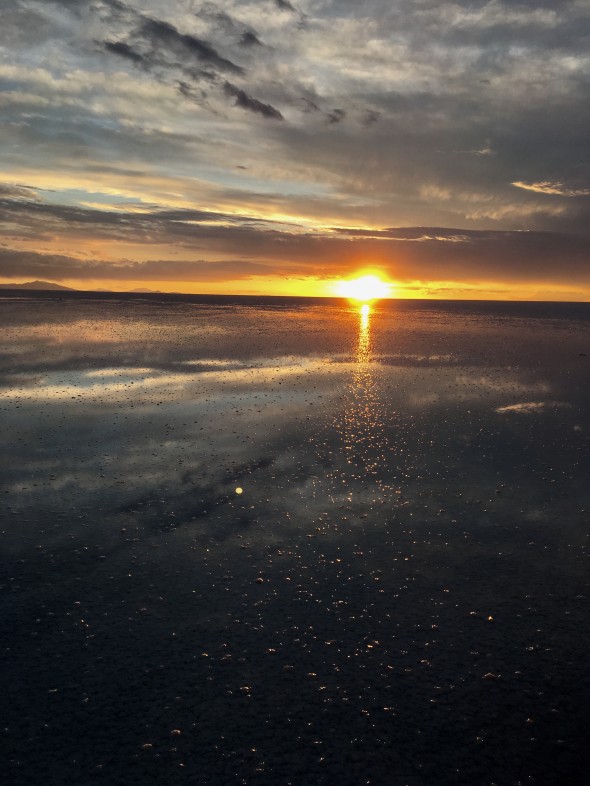
The next morning we embarked on the 3-day tour with a different guide, English-speaking Jairo, and Spanish-speaking Osbaldo the driver. Our chariot would be a Toyota Landcrusier and these are the only other types of vehicles we’d encounter on the road the next few days, as most of the route was unpaved and quite a bit required 4 wheel drive. Osbaldo turned out to be a skillful driver & mechanic, even helping out a couple different other drivers who we saw stopped en route (with tourists in the car). Besides transportation to a planned large number of sites, the tour included 3 meals per day and lodging in basic hostels- some had WiFi and hot water, others..not really. The sites and landscape were all worth it, simply amazing. And as remote as some of the sites, I was kind of impressed that the accommodations were are good as they were.
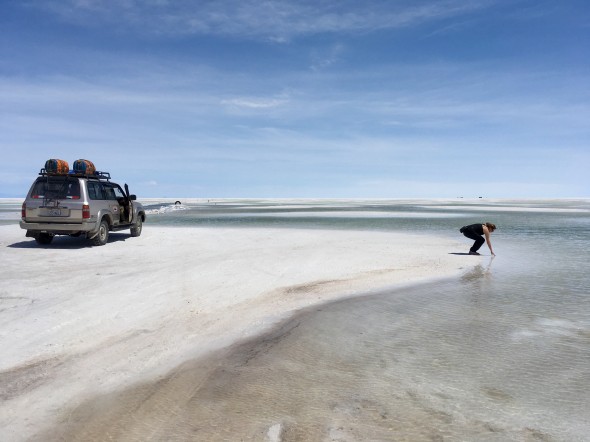
We sat a lot, but also hopped in and out of the Landcruiser many times each day, and got to walk around at many of the stopping points. It would be awesome to bike or trek across this land, but would take so much more time & logistical planning. I know many people travel through Bolivia on motorcycle or bicycle; we saw a a handful of cyclists but since we were on mostly unpaved, 4wd-necessary roads, I’m sure this is why we didn’t see more people biking.
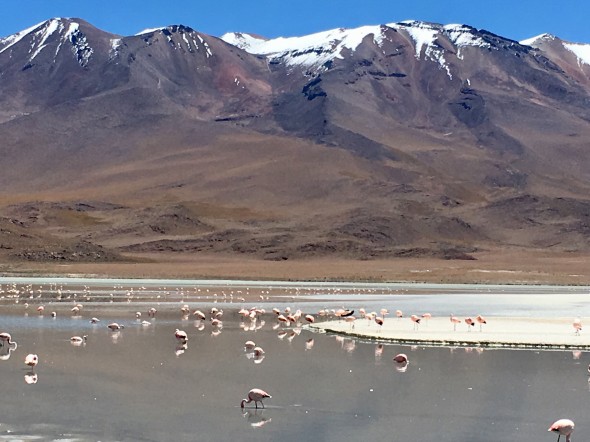
Carrie and I giggled ourselves to sleep most nights, like little girls at camp, arose early (me complaining, her kindly encouraging me), and so far we are super travel companions. For me, it’s enjoyable to have a travel partner at this point in my journey. I’ve actually really liked traveling and visiting places solo for much of this past year, but now it’s fun and meaningful to share these experiences with someone.
So far I’ve found some Bolivians to be polite & somewhat accommodating, but not very friendly (especially the older women, some who have been downright rude); they are proud of their amazing land and hard-working.
Some quick facts about Bolivia: its Salar (salt desert) produces 80% of the salt in the world, the country also produces 60-70% of the lithium in the wold. Until the 1980s, exportation of a long list of high-quality minerals was Bolivia’s main industry & trade export. Then it seems the quality diminished and the exportation slowed. But the landscape is still chock-full of minerals and crazy extremes. Our entire tour occurred above 10,000 feet. The high point: 16,043 feet (4,890m) where other mountains still rose higher around us, and we marveled at thermal vents spewing steam and what looked like pools of various colored boiling paint. In only one department (like a state), exist more than 120 lakes and lagoons, many which are multicolored due to the minerals or micro-algae they contain, and which are home to flamingos, seagulls, vicunas (similar to llamas but smaller). Other wildlife we saw along the way included many many llamas, armadillos, ostrich, and a large rodent that looked like a rabbit which lives amongst high altitude rocks. Oh yes, and Bolivia grows a huge amount of quinoa as well. Additionally, according to our guide who had attended a special tourism school, Bolivia is working hard on sustainable tourism, as there is so much here to not only export but to invite the world to come and see.
